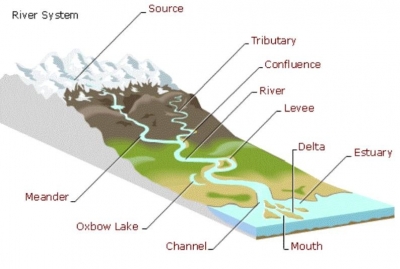
|
Rivers start off as small springs and streams high in the mountains. As they tumble downhill, they are joined by other streams, called tributaries, and become broader as they flow further. Upon reaching flat plains, they flow smoothly and deeply until they empty their waters into the sea or a lake. |
Most rivers begin their life high up in the mountains and hills of the world. There are heavy downpours of rain here and perhaps melting snow. Some of the rain soaks into the ground and the rest runs over the surface, collects in pools, then trickles downhill with the force of gravity. Small streams are formed, which get bigger as they collect more water and join up with other streams. The ever-increasing stream wears away the ground as it goes, carving out valleys and shaping the landscape. The speed of the flowing water and the hardness of the ground have an effect on the shape created. The ‘wearing away’ is called erosion.
A mountain stream is sometimes called a youthful river and it is fast flowing, making deep valleys with steep sides. Once it begins to cut a valley it is trapped in it and will continue to carve out the same valley for perhaps thousands of years. As it tumbles downhill, the stream collects and carries rocks, stones and pebbles along with it. Progressing on its journey towards the sea, it collects more and more water until it is big enough to be called a river. Eventually, the land becomes flatter and the water flow slows down, causing the river to drop its stones and pebbles onto the river bed. This is called deposition. As an ‘old river’ meanders slowly through flat land (a bend in a river is called a meander), it is carrying only mud.
Eventually a river meets the sea and the place where it does is called the mouth. The last of the mud is deposited at the river’s mouth. A wide mouth is called an estuary. Some estuaries are enormous – the estuary of the Amazon is 333 kilometres wide!
Sometimes a lowland river winds so much that the looping meanders almost touch. The river may eventually erode away the narrow area of land between two loops so that its course runs straight and a horseshoe-shaped area of water is stranded – an ox-bow lake.
Credit: Young People’s Trust for the Environment (YPTE)
Picture Credit : Google




